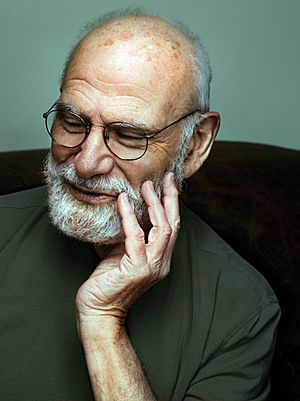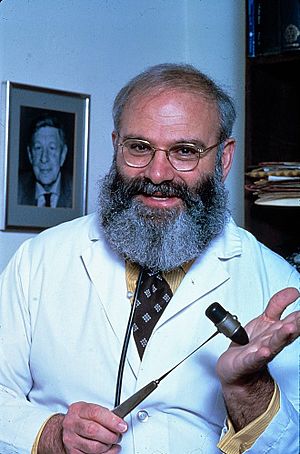Oliver Sacks facts for kids
Quick facts for kids
Oliver Sacks
|
|
|---|---|

Sacks in 2013
|
|
| Born |
Oliver Wolf Sacks
9 July 1933 London, England
|
| Died | 30 August 2015 (aged 82) New York City, U.S.
|
| Education | University of Oxford (BA 1954, BM BCh 1958) |
| Known for | Non-fiction books about his psychiatric and neurological patients |
| Medical career | |
| Profession | Physician, professor, author, neurologist |
| Institutions | New York University Columbia University Albert Einstein College of Medicine University of Warwick Little Sisters of the Poor |
| Sub-specialties | Neurology |
Oliver Wolf Sacks (born July 9, 1933 – died August 30, 2015) was a famous British doctor, scientist, and writer. He was known for his amazing books about people with unusual brain conditions. He was born in England and became a doctor there. Later, he moved to the United States, where he worked for most of his life.
Oliver Sacks trained to be a brain doctor, also called a neurologist. He worked at a hospital in New York, helping patients who had a rare sleeping sickness called encephalitis lethargica. These patients had been unable to move on their own for many years. His work with them became the basis for his 1973 book, Awakenings. This book was later made into a popular movie in 1990, starring Robin Williams and Robert De Niro.
Sacks wrote many other best-selling books. Most of these books shared stories about people, including himself, who had neurological disorders. These are conditions that affect the brain and nervous system. He also wrote many articles for both scientists and the general public. His writing was praised for being clear and beautiful. The New York Times called him a "poet laureate of contemporary medicine." This means he was like a poet for modern medicine. His books helped people understand how the brain works, especially with things like memory and how we see the world.
Oliver Sacks believed the brain is the "most incredible thing in the universe." His books and stories about brain conditions were so interesting that they were adapted into plays, movies, and even operas. He was honored with the CBE award in 2008 for his important work in medicine.
Contents
Early Life and School
Oliver Wolf Sacks was born in Cricklewood, London, England. He was the youngest of four children. His father, Samuel Sacks, was a doctor, and his mother, Muriel Elsie Landau, was one of the first female surgeons in England. Oliver came from a large family with many scientists and doctors.
When Oliver was six years old, during the Blitz in World War II, he and his older brother Michael were sent away from London to a boarding school. This was to keep them safe. He wrote about this time in his first autobiography, Uncle Tungsten: Memories of a Chemical Boyhood. When he returned home at age 10, he became very interested in chemistry, learning from his Uncle Dave. Later, he went to St Paul's School in London, where he made lifelong friends.
Studying to Become a Doctor
As a teenager, Oliver and his friends loved biology. He later decided to follow his parents' path and study medicine. In 1951, he started at The Queen's College, Oxford. He first studied physiology and biology, earning a degree in 1956.
After his first degree, Sacks chose to do extra research. He became interested in the history of medicine and how the body works. He spent time at a special lab, but he felt sad and disappointed because he didn't get much help. His family and tutor suggested he take a break.
In 1955, he spent a summer working on a farm in Israel called Ein HaShofet. This physical work helped him feel much better. He lost weight and felt healthier. He also traveled and went scuba diving in the Red Sea. This time helped him decide that he truly wanted to become a doctor. He realized that seeing patients and helping them was what he really wanted to do.
In 1956, Sacks began his clinical studies at the University of Oxford and Middlesex Hospital Medical School. For the next two and a half years, he took many courses in different areas of medicine. He even helped deliver babies at home. In 1958, he finished his medical degrees.
After graduating, Sacks started working at Middlesex Hospital. He gained more confidence by working in different hospital departments. By June 1960, he had completed his training year, but he was still thinking about his future.
Starting Life in North America
On his 27th birthday, July 9, 1960, Oliver Sacks left Britain and flew to Montreal, Canada. He visited medical centers and even thought about becoming a pilot. However, doctors there told him he would be better at medical research. He spent three months traveling across Canada, exploring the Canadian Rockies. He wrote about this trip in his journal, which was later published as Canada: Pause, 1960.
After Canada, he moved to the United States. He completed his medical training at Mt. Zion Hospital in San Francisco and UCLA. While in Los Angeles, he became a close friend of the poet Thom Gunn. Even though he lived in the U.S. for the rest of his life, he never became an American citizen. He liked to call himself a "resident alien," meaning he lived there but was still a visitor.
Career and Writing
Oliver Sacks taught neurology at several universities, including Albert Einstein College of Medicine, New York University School of Medicine, and Columbia University. At Columbia, he was named the first "Columbia University Artist." This special title recognized how his work connected science and the arts. He also taught as a visiting professor in the UK.
Sacks's work at Beth Abraham Hospital was very important. It helped create the Institute for Music and Neurologic Function (IMNF). This institute studies how music affects the brain. Sacks was honored by the IMNF for his contributions to music therapy and understanding the brain.
Sacks also had a busy medical practice in New York City. He was on the boards of important scientific and botanical organizations.
His Books and Stories
In 1967, Sacks started writing about his experiences with his patients. His books have been translated into over 25 languages. He also wrote regularly for famous magazines and newspapers like The New Yorker and The New York Times. In 2001, he won the Lewis Thomas Prize for Writing about Science.
Sacks's writing style was special. He wrote detailed stories about his patients, focusing on their experiences. He called this style "clinical anecdotes." He was inspired by the Russian neuropsychologist A. R. Luria, who became a good friend. Sacks's goal was to show how people with brain conditions could adapt and find ways to live full lives, even if their conditions were considered incurable.
His book Awakenings tells the story of his work with patients who had sleeping sickness. He used a new drug called levodopa to help them. This book was made into a movie and a ballet.
In his book A Leg to Stand On, Sacks wrote about his own experience. In 1974, he had a serious accident while mountaineering in Norway and badly injured his left leg.
Some of his other books describe people with conditions like Tourette syndrome and different effects of Parkinson's disease. The famous book The Man Who Mistook His Wife for a Hat tells the story of a man who had trouble recognizing faces and objects. This book was even made into an opera. Another book, An Anthropologist on Mars, includes a story about Temple Grandin, an autistic professor. Sacks believed that brain conditions could sometimes bring out amazing hidden abilities in people.
In The Island of the Colorblind, Sacks wrote about an island where many people were completely colorblind. He also wrote about a brain disease affecting the Chamorro people of Guam. He and another scientist, Paul Alan Cox, suggested that a toxin from a plant might be causing this disease.
His 2012 book, Hallucinations, explored why ordinary people sometimes experience hallucinations. He explained that hallucinations are not just for people with mental illness. They can also happen because of sensory loss, illness, or injury. He wrote about Charles Bonnet syndrome, which affects people who have lost their eyesight.
Sacks sometimes received criticism. Some people felt his work relied too much on personal stories. Others thought he might be using his patients' stories for his own career. Sacks always said he wrote with respect and appreciation for his patients.
He also wrote other books like The Mind's Eye and his second autobiography, On the Move: A Life.
Before he passed away, Sacks started the Oliver Sacks Foundation. This group aims to help people understand the brain through stories and case histories. They plan to publish some of his writings that haven't been seen before. His first book published after his death was River of Consciousness in 2017.
Awards and Honors
Oliver Sacks received many awards and honors throughout his life.
- In 1996, he became a member of the American Academy of Arts and Letters.
- He was named a Fellow of the New York Academy of Sciences in 1999.
- Also in 1999, he became an Honorary Fellow at the Queen's College, Oxford.
- In 2000, he received the Golden Plate Award from the American Academy of Achievement.
- In 2002, he became a Fellow of the American Academy of Arts and Sciences.
- He was also a Fellow of the Royal College of Physicians (FRCP).
Many universities gave him honorary doctorates, including Oxford University in 2005. In 2007, Columbia University created a special position for him called "Columbia Artist." This allowed him to work freely across different university departments.
In 2008, Sacks was appointed Commander of the Order of the British Empire (CBE) by the Queen for his services to medicine. A small planet, 84928 Oliversacks, discovered in 2003, was named in his honor.
Personal Life
Oliver Sacks never married and lived alone for most of his life. He shared more about his personal life later on. In his 2015 autobiography, On the Move: A Life, he wrote about his personal relationships. He had a close partnership with writer Bill Hayes that lasted until Sacks's death.
Sacks was described by a colleague as "deeply eccentric," meaning he had a very unique personality. He also mentioned that he had severe shyness, which he called a "disease." He believed this shyness was linked to his prosopagnosia, or "face blindness." This condition meant he sometimes had trouble recognizing faces, even his own in a mirror.
Oliver Sacks loved to swim almost every day. He was known for swimming long distances, sometimes even around an entire island near his home in New York.
Illness and Death
In 2006, Oliver Sacks had treatment for a type of cancer called uveal melanoma in his right eye. This treatment caused him to lose his 3D vision and eventually become blind in that eye. He wrote about this experience in his book The Mind's Eye.
In January 2015, doctors found that the cancer had spread to his liver. Sacks announced this news in a newspaper article in February 2015. He knew he had only a few months left to live. He wrote that he wanted to "live in the richest, deepest, most productive way I can." He hoped to spend his remaining time with friends, write more, and gain new understanding.
Oliver Sacks passed away from the disease on August 30, 2015, at his home in Manhattan. He was 82 years old and was surrounded by his closest friends.
See also
 In Spanish: Oliver Sacks para niños
In Spanish: Oliver Sacks para niños


